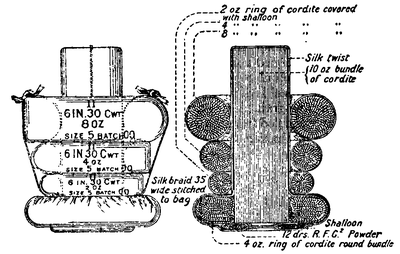For howitzers, variable charges are used, and are made up so that the weight can be readily altered. The following typical instance (fig. 22) will serve to show the general method of making up such charges, whether for B.L. or Q.F. howitzers. Small size cordite is used, and the charge is formed of a mushroom-shaped core, made up in a shalloon bag; on the stalk, so as to be easily removed, three rings of cordite are placed. The bottom of the core contains the primer, and the rings can be attached to the core by two silk braids. The weight of the rings is graduated so that by detaching one or more the varying charges required can be obtained.

|
Fig. 23.—6-pr. Q.F. Cartridge. |

|
Fig. 24.—4·7-inch Q.F. Cartridge |
For quick-firing guns the charge is contained in a brass case to which is fitted a primer for igniting the charge. This case is inserted into the gun, and when fired slightly expands and tightly fits the chamber of the gun, thus acting as an obturator and preventing any escape of gas from the breech. This class of ammunition is especially useful for the smaller calibres of guns, such as 3-pr., 6-pr. and field guns, but Messrs Krupp also employ metallic cartridge cases for the largest type of gun, probably on account of the known difficulty of ensuring trustworthy obturation by any other means practicable with sliding wedge guns.
The charges for these cases are made up in a very similar manner to those already described for B.L. guns. Where necessary, distance pieces formed of papier-mâché tubes and felt wads are used to fill up the space in the case and so prevent any movement of the charge. The mouth of the case is closed either by the base end of the projectile (fig. 23), in which case it is called “fixed ammunition” or “simultaneous loading ammunition,” or by a metallic cap (fig. 24), when it is called “separate loading ammunition,” the projectile and charge being thus loaded by separate operations. (A. G. H.)
The Bullet.—The original musket bullet was a spherical leaden ball two sizes smaller than the bore, wrapped in a loosely fitting paper patch which formed the cartridge. The loading was, therefore, easy with the old smooth-bore Brown Bess and similar military muskets. The original Small-arms ammunition.muzzle-loading rifle, on the other hand, with a closely fitting ball to take the grooves, was loaded with difficulty, particularly when foul, and for this reason was not generally used for military purposes.
In 1826 Delirque, a French infantry officer, invented a breech with abrupt shoulders on which the spherical bullet was rammed down until it expanded and filled the grooves. The objection in this case was that the deformed bullet had an erratic flight. The Brunswick rifle, introduced into the British army in the reign of William IV., fired a spherical bullet weighing 557 grs. with a belt to fit the grooves. The rifle was not easily loaded, and soon fouled. In 1835 W. Greener produced a new expansive bullet, an oval ball, a diameter and a half in length, with a flat end, perforated, in which a cast metallic taper plug was inserted. The explosion of the charge drove the plug home, expanded the bullet, filled the grooves and prevented windage. A trial of the Greener bullet in August 1835, at Tynemouth, by a party of the 60th (now King’s Royal) Rifles, proved successful. The range and accuracy of the rifle were retained, while the loading proved as easy as with a smooth-bore musket. The invention was, however, rejected by the military authorities on the ground that the bullet was a compound one. In 1852 the government awarded Minié, a Frenchman, £20,000 for a bullet of the same principle, adopted into the British service. Subsequently, in 1857, Greener was also awarded £1000 for “the first public suggestion of the principle of expansion, commonly called the Minié principle, in 1836.” The Minié bullet contained an iron cup in a cavity in the base of the bullet. The form of the bullet was subsequently changed from conoidal to cylindro-conoidal, with a hemispherical iron cup. This bullet was used in the Enfield rifle introduced into the British army in 1855. It weighed 530 grs., and was made up into cartridges and lubricated as for the Minié rifle. A boxwood plug to the bullet was also used. The bullet used in the breech-loading Martini-Henry rifle, adopted by the British government in 1871 in succession to the Snider-Enfield rifle, weighed 480 grs., and was fired from an Eley-Boxer cartridge-case with a wad of wax lubrication at the base of the bullet.
Between 1854 and 1857 Sir Joseph Whitworth conducted along series of rifle experiments, and proved, among other points, the advantages of a smaller bore and, in particular, of an elongated bullet. The Whitworth bullet was made to fit the grooves of the rifle mechanically. The Whitworth rifle was never adopted by the government, although it was used extensively for match purposes and target practice between 1857 and 1866, when

